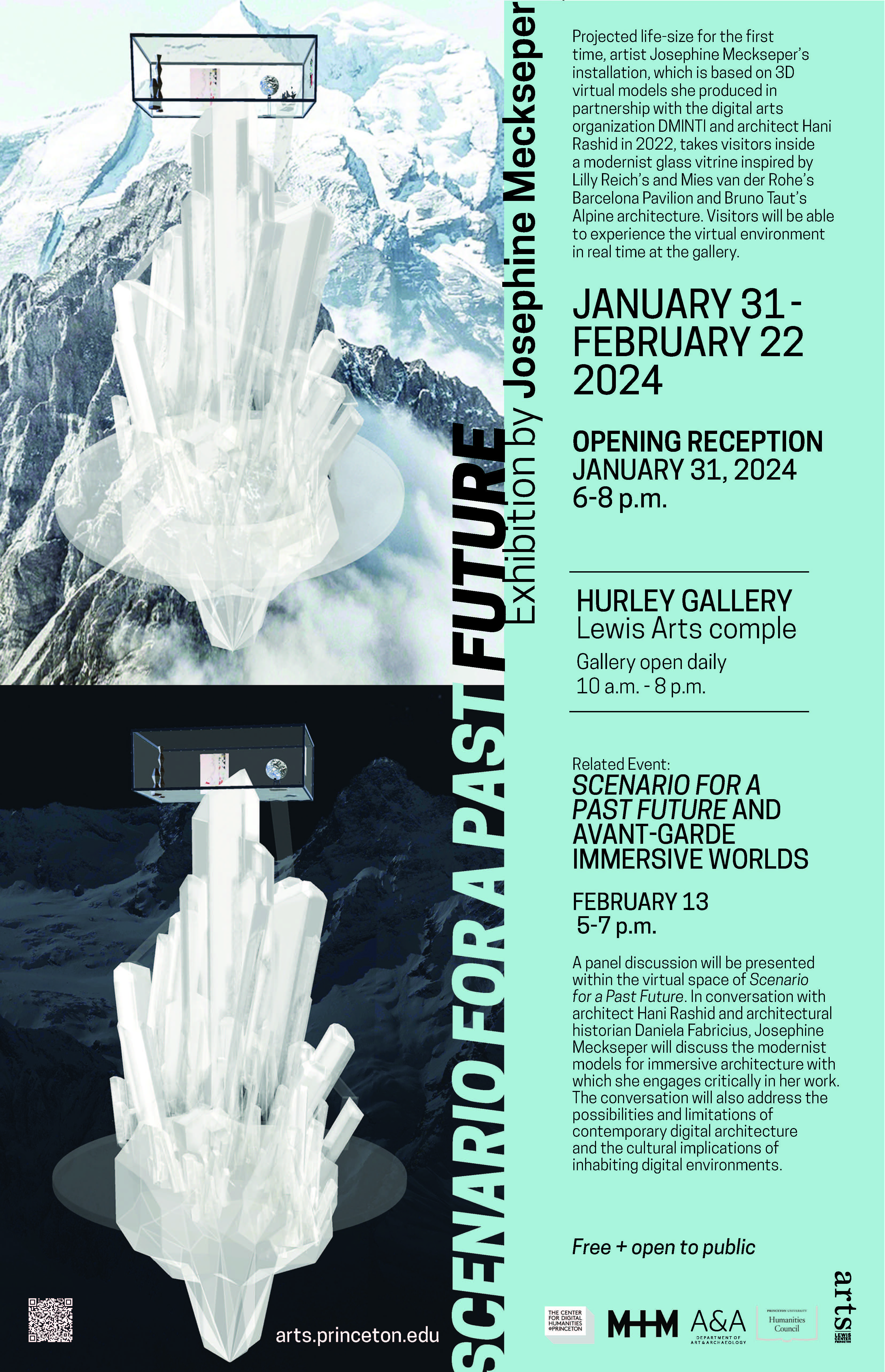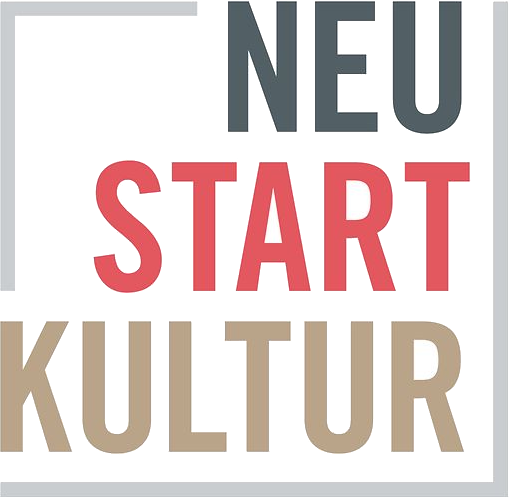Solo Show „Josephine Meckseper. Scenario for a Past Future“
31.01.2024 - 22.02.2024
Opening: Wednesday, January 31, 2024, Forum: 6-8 p.m.
Lewis Center for the Arts, Hurley Gallery, Princeton University

Lewis Center for the Arts and Department of Art & Archaeology present „Scenario for a Past Future“. An Exhibition by artist Josephine Meckseper. It is an interactive multimedia installation that allows visitors to experience the virtual environment in real time at the gallery.
On February 13, a panel discussion featuring the artist, architect Hani Rashid, and architectural historian Daniela Fabricius, will be presented within the virtual space
of the exhibition.
What/Who: Artist Josephine Meckseper, former Belknap Visiting Fellow in the Humanities Council and Department of Art & Archaeology at Princeton, presents an interactive multimedia installation, „Scenario for a Past Future“, at the Lewis Center for the Arts’ Hurley Gallery. Projected life-size for the first time, Meckseper’s virtual artwork, based on 3D virtual models she produced in partnership with the digital arts
organization DMINTI and architect Hani Rashid in 2022, takes visitors inside a modernist glass vitrine inspired by Lilly Reich’s and Mies van der Rohe’s Barcelona Pavilion and Bruno Taut’s Alpine architecture. Visitors will be able to experience and enter the virtual environment in real time at the gallery. The exhibition also includes an „animated painting,“ „Sidewalk Cinema“ (2022), displayed as a digital video projection on a monitor. On February 13 from 5-7 p.m., Meckseper, Rashid, and architectural historian Daniela Fabricius will discuss the modernist models for immersive architecture with which Meckseper engages critically in her work, the possibilities and limitations of contemporary digital architecture, and the cultural implications of inhabiting digital
environments. The panel discussion, cosponsored by Princeton’s Humanities Council, Center for Digital Humanities, and Program in Media and Modernity, will be presented in
the virtual space of the exhibition and will also be accessible remotely in a Zoom Webinar.
When: On view January 31-February 22. Opening reception January 31 at 6-8 p.m.
Virtual panel discussion February 13 at 5 p.m.
Where: Hurley Gallery at Lewis Arts complex on the Princeton University campus. Panel discussion can be attended in-person at the Gallery where the panel will be projected or
from anywhere via Zoom Webinar.
Gallery Hours: Daily from 10 a.m. - 8 p.m.
Admission: Free and open to the public.
Accessibility: The Hurley Gallery is an accessible venue. Guests in need of access accommodations are invited to contact the Lewis Center at LewisCenter@princeton.edu
at least one week prior to the date of their visit.
For more information and Zoom Webinar registration:
https://arts.princeton.edu/events/scenario-for-a-past-future-exhibition-by-josephinemeckseper/
2024-01-31/
(Princeton, NJ) The Lewis Center for the Arts and Department of Art and Archaeology at Princeton University will present „Scenario for a Past Future“, an interactive multimedia
installation by artist Josephine Meckseper at the Lewis Center’s Hurley Gallery at the Lewis Arts complex January 31 through February 22. The work will be on view 10 a.m.
to 8 p.m. daily with an opening reception on January 31 at 6 to 8 p.m. On February 13 at 5 p.m., Meckseper will be joined by collaborator and architect Hani Rashid and architectural historian Daniela Fabricius for a panel discussion presented in the virtual space of the exhibition. The panel discussion can be attended in the gallery or via Zoom Webinar. The Hurley Gallery is an accessible venue and guests in need of access
accommodations are invited to contact the Lewis Center at LewisCenter@princeton.edu at least one week prior to the date of their visit. The exhibition, reception and panel
discussion are free and open to the public.
Meckseper was a 2022-23 Belknap Fellow in Princeton’s Humanities Council, coteaching an interdisciplinary seminar, „Counterworlds: Innovation and Rupture in Communities of Artistic Practice“ with Princeton art historian Brigid Doherty, and presenting a lecture in collaboration with the Princeton University Art Museum. Born in Germany and living and working now in New York City, Meckseper is known for largescale vitrine installations and films that meld the aesthetic language of 20th-century modernism with her own imagery of historical undercurrents. Her works, encompassing sculpture, painting, photography, and film, simultaneously expose and encase cultural signifiers and everyday objects to form an investigation into the collective unconscious of our time. Meckseper’s works have been published extensively in monographs and shown in numerous museum solo exhibitions worldwide, including the Frac des Pays de la
Loire, Nantes (2019); the Migros Museum für Gegenwartskunst, Zurich (2009); the Indianapolis Museum of Art, Indianapolis, (2009); the Museum of Modern Art, New
York City (2008); and the Kunstmuseum, Stuttgart (2007). She was included in international biennials such as the NGV Triennial, Melbourne, Australia (2017); the Taipei Biennial, Taiwan (2014); and the Whitney Biennial, New York (2006 and 2010).
Meckseper was named a Fellow of the John Simon Guggenheim Memorial Foundation in 2022. Her works are in the permanent collections of major institutions, including the Whitney Museum of American Art, New York City; the Solomon R. Guggenheim Museum, New York City; the Museum of Modern Art, New York City; the Metropolitan
Museum, New York City; and the Hammer Museum, Los Angeles.
In her return to Princeton, Meckseper presents „Scenario for a Past Future“. Projected lifesize for the first time, Meckseper’s virtual artwork, which is based on 3D virtual models she produced in partnership with the digital arts organization DMINTI and architect Hani Rashid in 2022, takes visitors inside a modernist glass vitrine inspired by Lilly Reich’s
and Mies van der Rohe’s Barcelona Pavilion (1929) and Bruno Taut’s Alpine architecture (1917). The work features a soundscape combining modernist and electronic musical
vocabularies inspired by the compositions of Karlheinz Stockhausen. Visitors will be able to experience and enter the virtual environment in real time at the gallery. The exhibition
also includes an „animated painting,“ „Sidewalk Cinema“ (2022), displayed as a digital video projection on a monitor.
On February 13 at 5 p.m., Meckseper will join Rashid and architectural historian Daniela Fabricius to present a panel discussion, entitled „Scenario for a Past Future and Avant-
Garde Immersive Worlds“, within the virtual space of the exhibition. Meckseper will discuss the modernist models for immersive architecture with which she engages
critically in her work, while also addressing the possibilities and limitations of contemporary digital architecture and the cultural implications of inhabiting digital environments. The panel is cosponsored by Princeton’s Humanities Council, Center for Digital Humanities, and Program in Media and Modernity. Guests can join the panel discussion in the Hurley Gallery where the panel will be projected or from anywhere via
Zoom Webinar (registration link at arts.princeton.edu).
Rashid of Asymptote Architecture is a practicing architect, known for a first-of-its-kind Guggenheim Virtual Museum and the Virtual New York Stock Exchange among other notable projects and buildings including the Yas Marina Hotel and Formula 1 venue in Abu Dhabi. He has held visiting professorships at the Royal Academy of Fine Arts in Copenhagen, the Southern California Institute of Architecture in Los Angeles, at Harvard University Graduate School of Design, and the Swiss Federal Institute of Technology
(ETH), and he co-founded and developed Columbia University GSAAP Advanced Digital Design program. Rashid co-represented the United States at the 7th Venice
Architecture Biennale in 2000.
Fabricius is a historian and theorist of architecture and urbanism and an assistant professor in architecture at the University of Pennsylvania. She is the author of the
forthcoming book „The Ethics of Calculation: Architecture and Rationalism in Postwar Germany“, as well as an edited volume of the writings of the feminist theorist Jennifer
Bloomer. Her recent research includes the history of spatial forms of social and ecological reparations, and the contested transformations of East Germany after 1989. Her work has been supported by the Graham Foundation, the New York State Council on the Arts, a DAAD Research Fellowship, and a Whiting Doctoral Fellowship.
The exhibition and panel discussion are organized by Associate Professor Brigid Doherty in the Department of Art & Archaeology and Professor Jeffrey Whetstone in the Program in Visual Arts in the Lewis Center in collaboration with Josephine Meckseper, with technical support from Jacqueline Sischy and Sam Hillmer of DMINTI.
For more information on this event or any of the more than 100 performances, exhibitions, readings, screenings, and lectures presented annually by the Lewis Center for
the Arts, most of them free, visit arts.princeton.edu.


